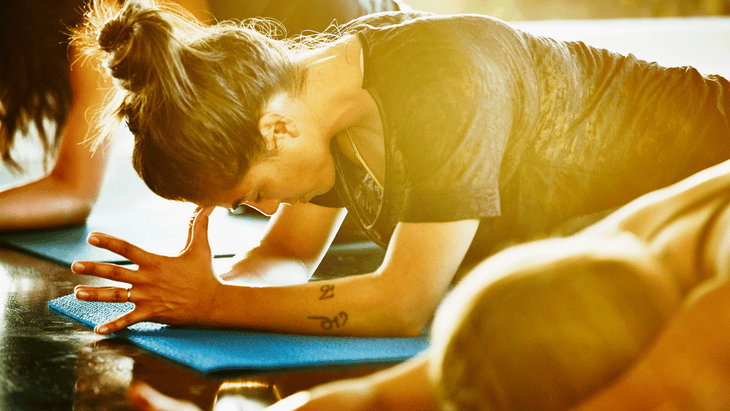“], “filter”: { “nextExceptions”: “img, blockquote, div”, “nextContainsExceptions”: “img, blockquote, a.btn, a.o-button”} }”>
Heading out the door? Read this article on the new Outside+ app available now on iOS devices for members!
>”,”name”:”in-content-cta”,”type”:”link”}}”>Download the app.
Straight out of my first yoga teacher training, I thought I knew exactly how to keep my students safe. Where to position their front knee to protect the vulnerable joint in standing poses. How to position their upper body to prevent shoulder damage as they navigate Chaturanga Dandasana. How to engage their core in backbends so they wouldn’t “dump” into their low back.
I “corrected” positions in Warrior poses to “preserve their knees,” cautioned students to hold their shoulders back and down to “safeguard their shoulder joints,” and repeatedly suggested they engage their core or corrected pelvic positions in backbends to “protect their low back.”
But the longer I taught and the more students I “kept safe,” the less certain I became. These yoga cues seemed to have no impact on low back pain, knee pain, and shoulder pain. I saw many students begin to feel less stable rather than more supported. Worse, students who had been practicing yoga for years began to question their own judgement and adjust their position in response to my cues, whether or not that felt better to them.
Every good teacher wants to create a safe and supportive environment for students and share cues that help them be better friends to their bodies. But as well-intentioned as I was, my teaching style I might have had the opposite effect—leaving students feeling vulnerable instead of safe, fragile rather than resilient.
What We Can Learn From Pain Science
I started to question my “safety first” approach after being introduced to pain science. I still encouraged my students to back away from any pain during yoga practice, although what I learned forced me to reassess my beliefs around safety. That is, I had to rethink what creates a feeling of safety and self-confidence and, crucially, what can do the opposite.
Rather than a simple, straightforward signal of damage from the body, pain is output from the brain based on its interpretation of information. This information is supplied by sensory neurons called nociceptors, which register potential threats to our bodies through information such as changes in temperature, chemical balance, and pressure. The brain’s interpretation of whether or not that nociceptive signal is perceived as painful is shaped by cues from our external environment—including our beliefs and prior experiences.
How Words Can Hurt
Wondering how that information is relevant in yoga? A recent study concluded that hearing words related to pain increased activity in the same regions of the brain as those activated by actual pain or nociceptive stimuli. That means just hearing words related to pain activates the same parts of the brain as actual pain!
You might think, but I don’t use words related to pain when I teach. Here’s the thing: our brains are prediction machines, adept at filling in the blanks and drawing conclusions from incomplete information. Given that, it’s possible that words that invoke the potential for damage, injury, or pain could have the same effect. Suggesting that a certain position or action will “protect your low back” might lead students to believe that a different position or action could do the opposite. Even thinking about the potential for injury or pain can light up the pain-processing regions of the brain.
Moreover, people who are anxious, fearful, or in pain become sensitive to nociceptive signals. They are more likely to experience pain (ie interpret nociceptive nerve inputs as painful) and report greater intensity of negative sensation when they do.
Knowing this, you can imagine the cycle I was inadvertently creating as a cautious new teacher each time I offered cues such as “protect your low back,” “safeguard your shoulder joints,” or “preserve your knees.” The more often I cued for safety, the more likely my students were to hear danger, and therefore the more likely they were to interpret signals from their bodies as pain. It wasn’t quite the safe haven I had intended to create in my classes.

Understanding Psychological Safety
In the context of actions we take in everyday life—such as driving a car, picking up a squirming child, lugging around a heavy bag, and other things we do without thinking—yoga is very safe. We are much less likely to injure ourselves on the mat than off it.
Also, our bodies are less fragile than we think. They actually thrive in response to challenge. Weight training makes our muscles stronger. Aerobic training makes our cardiovascular system more efficient. This is what statistical mathematician, risk analyst, and author Nassim Nicholas Taleb calls “antifragility.”
So as yoga teachers, perhaps we don’t need to worry so much about our student’s physical safety. (Although there’s obviously more to consider when teaching therapeutic classes for special populations.) Instead of the “teacher knows best” approach, our students might benefit more from a class environment in which they’re offered an array of options. This helps them feel confident in their own capacity—open to explore and experiment, able to ask questions or make their own decisions about what works for them. This feeling is called psychological safety.
Yoga Cues that Empower
Over the past few years, I’ve been revising my verbal cues to focus on psychological safety rather than physical safety. Instead of “engage your abdominals to protect your low back” in Locust Pose (Salabhasana), I might say “draw your pubic bone toward your navel and see if it creates length along your low back and sacrum.”
Instead of setting students up for low push-up (Chaturanga Dandasana) with a reminder to “be careful with your alignment to keep your shoulders safe,” I might talk them through some options that they could employ to help their ”shoulders feel strong and stable.”
In One-Legged Pigeon (Eka Pada Rajakapotasana), instead of directing students to “flex your front toes to protect your knee,” I help them find “a position for your front foot that is comfortable enough to relax here.”
Every good teacher wants to keep their students safe, but we also want our students to feel confident in their own bodies. Now that I appreciate the role of language in shaping student experience, I can alter the experience to be an empowering one.













